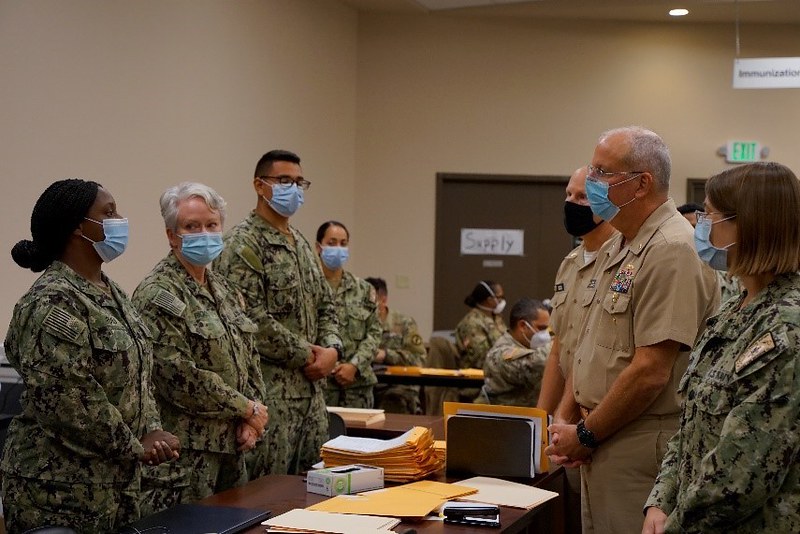Operation Allies Welcome
November 29, 2021
The U.S. has maintained a military presence in Afghanistan for 20 years, starting with Operation Enduring Freedom on Oct. 7, 2001, and thus, the Global War on Terrorism. 2021 served as the year that American troops would be pulled out of the Middle Eastern country, but this process was bluntly interrupted and sped up by the rapid movements by the Taliban, the insurgent group the U.S. military ousted in 2001 during its search for Osama Bin Laden. The Taliban swiftly regained power over Afghanistan that was previously lost, forcing American troops and civilians, as well as Afghans who had worked for or were associated with the US, to frantically flee the country.
Thousands of these Afghan refugees, many of whom were airlifted from Hamid Karzai International Airport in Afghanistan’s capital of Kabul, were brought to the U.S., where they could be provided with the resources and assistance they needed to form a new life outside of their country. This organized resettling of vulnerable Afghans, known as Operation Allies Welcome, is headed by the Department of Homeland Security and backed up by components of the military. Afghan refugees are housed and cared for at several different Marine, Army, and Air Force bases around the U.S.
“The majority of Afghans who will be resettled in the United States in the coming weeks have worked directly for the United States on its mission in Afghanistan, and including across military, diplomatic, and developmental efforts – or in some cases, they are a family member of someone who did those things,” stated an official from the Department of State.
Upon arrival at one of a set of designated military installations, the refugees are given medical aid, food, their own bunks, and are accommodated on different aspects of daily life including religion and education. In addition, thanks to the recently passed Extending Government Funding and Delivering Emergency Assistance Act, they are assisted with finances, health insurance, and applying for immigrant visas and permanent citizenship.
To make this operation possible thousands of men and women serving the Department of Homeland Security, United States Army National Guard and Marines have been called up from every corner of the U.S. As a result, though the focus is mainly on taking care of the Afghan refugees, the mix of individuals serving them has also helped bring a span of cultures together. Interactions between Americans of all backgrounds and their Afghan guests have forged bonds between those in need and their Good Samaritans.
“I thought I could make an immediate impact coming here. I know these struggles, and I also know how to overcome the stigma and challenges many of these people are facing,” stated Staff Sergeant Sharon Queenie, who was called from her National Guard unit in Alaska and is a descendant of the Yupik tribe of Native Americans. Queenie felt that she should answer the call for volunteers due to her own experience with cultural identity and vulnerability, things that the refugees are currently dealing with.
For others, volunteering for this operation is simply part of what it means to serve in the armed forces and to help those who are in need. Serving others on the homefront is just as crucial as being on active duty overseas.
“At the time I signed up for this, I didn’t know what to expect, but I knew something had to be done. That’s pretty much the inherent mission of the National Guard … have a giant group of people prepared to do whatever’s required and do the right thing for people in need,” stated Master Sergeant Christopher Davas.
Furthermore, refugees who have been airlifted from Afghanistan are also being housed in international U.S. military bases in regions such as Qatar and Kuwait.
Without a doubt, the group that benefits from this operation the most is the Afghan refugees themselves. For them, leaving Afghanistan means more than reaching safety. It means leaving behind their livelihoods, family, and friends who are still in the country. Their new journey to the United States parallels the one Europeans who once came through Ellis Island took, or the one that tens of thousands of Vietnamese refugees who were forced to leave their country in a similar fashion, after the fall of South Vietnam and its capital of Saigon on Apr. 30, 1975, followed. Thanks to Operation Allies Welcome and other missions like it, these Afghan men, women and children who had no choice but to leave their lives behind now have a brighter future.
“With such a diverse force, we have overcome all challenges thrown our way,” he said. “All of this to help save lives of our partners in Afghanistan who have literally left everything they had for a chance to start over in the U.S.,” stated Air Force Lieutenant Colonel Thomas Bauer.
Photographic Courtesy of FLICKR.COM

